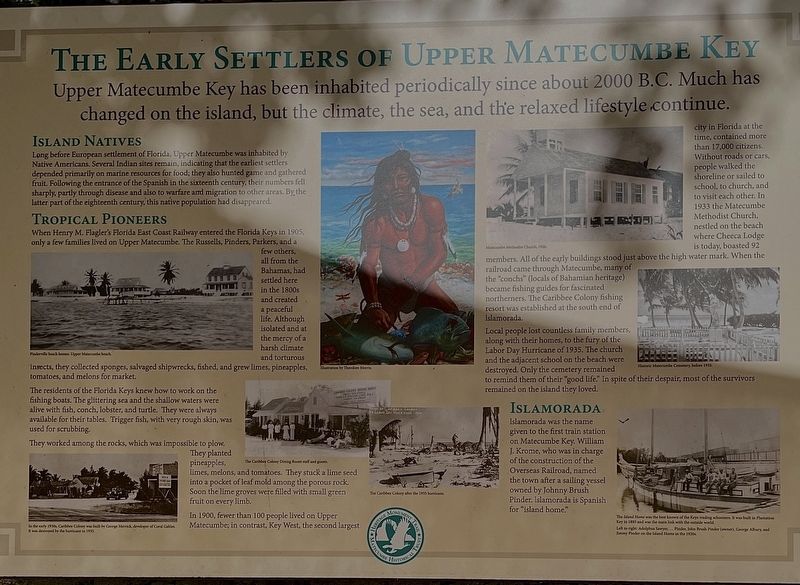Islamorada in Monroe County, Florida — The American South (South Atlantic)
The Early Settlers of Upper Matecumbe Key
— Heritage Monument Trail, Matacumbe Historical Trust —
Upper Matecumbe Key has been inhabited periodically since about 2000 B.C. Much has changed on the island, but the climate, the sea, and the relaxed lifestyle continue.
Island Natives
Long before European settlement of Florida, Upper Matecumbe was inhabited by Native Americans. Several Indian sites remain, indicating that the earliest settlers depended primarily on marine resources for food; they also hunted game and gathered fruit. Following the entrance of the Spanish in the sixteenth century, their numbers fell sharply, partly through disease and also to warfare and migration to other areas. By the latter part of the eighteenth century, this native population had disappeared.
Tropical Pioneers
When Henry M. Flagler's Florida East Coast Railway entered the Florida Keys in 1905, only a few families lived on Upper Matecumbe. The Russells, Pinders, Parkers, and a few others, all from the Bahamas, had settled here in the 1800s and created a peaceful life. Although isolated and at the mercy of a harsh climate and torturous insects, they collected sponges, salvaged shipwrecks, fished, and grew limes, pineapples, tomatoes, and melons for market.
The residents of the Florida Keys knew how to work on the fishing boats. The glittering sea and the shallow waters were alive with fish, conch, lobster, and turtle. They were always available for their tables. Trigger fish, with very rough skin, was used for scrubbing.
They worked among the rocks, which was impossible to plow. They planted pineapples, limes, melons, and tomatoes. They stuck a lime seed into a pocket of leaf mold among the porous rock. Soon the lime groves were filled with small green fruit on every limb.
In 1900, fewer than 100 people lived on Upper Matecumbe; in contrast, Key West, the second largest city in Florida at the time, contained more than 17,000 citizens. Without roads or cars, people walked the shoreline or sailed to school, to church, and to visit each other. In 1933 the Matecumbe Methodist Church, nestled on the beach where Cheeca Lodge is today, boasted 92 members. All of the early buildings stood just above the high water mark. When the railroad came through Matecumbe, many of the "conchs" (locals of Bahamian heritage) became fishing guides for fascinated northerners. The Caribbee Colony fishing resort was established at the south end of Islamorada.
Local people lost countless family members, along with their homes, to the fury of the Labor Day Hurricane of 1935. The church and the adjacent school on the beach were destroyed. Only the cemetery remained to remind them of their "good life.” In spite of their despair, most of the survivors remained on the island they loved.
Islamorada
Islamorada was the name given to the first train station on Matecumbe Key. William J. Krome, who was in charge of the construction of the Overseas Railroad, named the town after a sailing vessel owned by Johnny Brush Pinder. Islamorada is Spanish for "island home."
(captions)
Pinderville beach homes. Upper Matecumbe beach.
In the early 1930s, Caribbean Colony was built by George Merrick, developer of Coral Gables.
Illustration by Theodore Morris.
The Caribbean Dining Room staff and guests.
The Caribbean Colony after the 1935 Hurricane.
Matecumbe Methodist Church, 1926.
Historic Matecumbe Cemetery, before 1935.
The Island Home was the best known of the Keys trading schooners. It was built in Plantation Key in 1885 and was the main link with the outside world.
Left to right: Aldolphus Sawyer, … Pinder, John Brush Pinder (owner), George Albert, and Jimmy Pinder on the Island Home in the 1920s.
Erected by Heritage Monument Trail, Matacumbe Historical Trust.
Topics. This historical marker is listed in these topic lists: Agriculture • Environment • Native Americans • Railroads & Streetcars • Settlements & Settlers. A significant historical year for this entry is 1905.
Location. 24° 55.574′ N, 80° 37.581′ W. Marker is in Islamorada, Florida, in Monroe County. Marker can be reached from Overseas Highway (U.S. 1) north of North Ocean Lane (County Route 931), on the left when traveling north. Touch for map. Marker is at or near this postal address: 82616 Overseas Highway, Islamorada FL 33036, United States of America. Touch for directions.
Other nearby markers. At least 8 other markers are within walking distance of this marker. Geological History of the Florida Keys (here, next to this marker); The Spanish Treasure Fleets (here, next to this marker); Native Americans (here, next to this marker); The Florida Keys Memorial (here, next to this marker); The Railway That Went To Sea (a few steps from this marker); The Storm that Still Howls (a few steps from this marker); Site of Islamorada Railway Station (approx. ¼ mile away); The 1935 Hurricane (approx. 0.9 miles away). Touch for a list and map of all markers in Islamorada.
Also see . . .
1. History of Upper Matecumbe Key. (Submitted on May 29, 2023, by Brandon D Cross of Flagler Beach, Florida.)
2. Heritage Monument Trail, Matacumbe Historical Trust. (Submitted on May 29, 2023, by Brandon D Cross of Flagler Beach, Florida.)
Credits. This page was last revised on June 7, 2023. It was originally submitted on May 29, 2023, by Brandon D Cross of Flagler Beach, Florida. This page has been viewed 86 times since then and 21 times this year. Photo 1. submitted on May 29, 2023, by Brandon D Cross of Flagler Beach, Florida. • Bernard Fisher was the editor who published this page.
